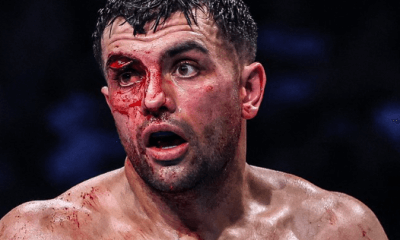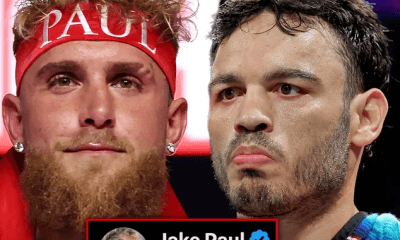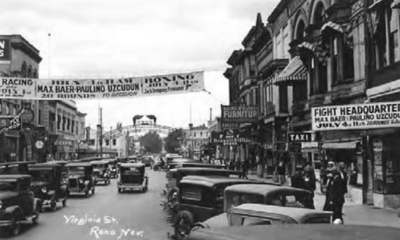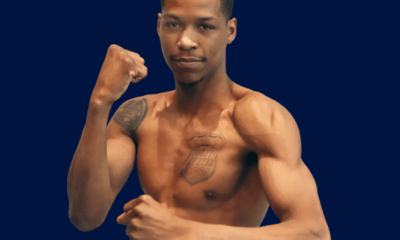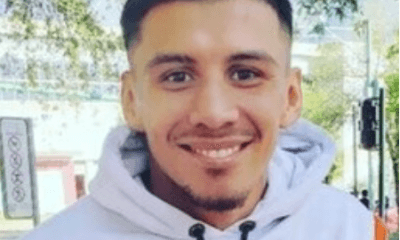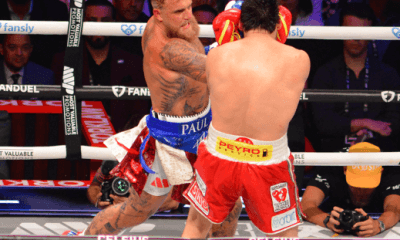Featured Articles
The Other Four Kings
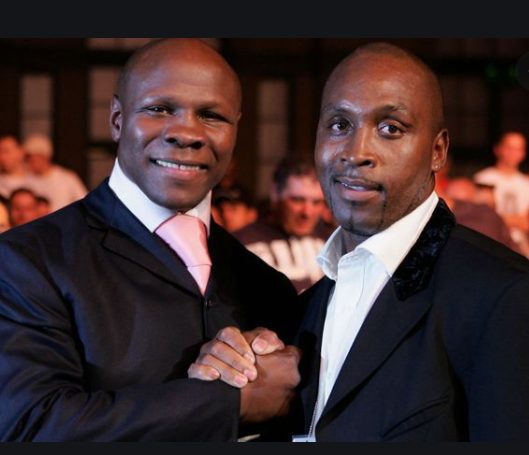
“During the1980s,” wrote TSS editor Arne Lang in a recent article, “Marvelous Marvin Hagler, Sugar Ray Leonard, Thomas Hearns, and Roberto Duran enlivened the sport, fighting each other in what amounted to a round-robin, nine fights in all fought across four weight divisions. Looking back 20-odd years later, the late Boston Herald (and TSS) columnist George Kimball dubbed them the Four Kings, a name that would stick.”
Arne went on to state: “It seems inevitable that [Devin] Haney, [Teofimo] Lopez, [Ryan] Garcia, and [Gervonta] Davis will cross paths with each other before their careers are finished. More than one writer has dubbed the quartet the new Four Kings.”
Maybe so, but let’s slow this down a bit before the memory of four other kings fades away. These particular four traveled on the U.K. Expressway, a uniquely fast, ferocious, and furious pathway. They were Chris Eubank, Carl Thompson, Nigel Benn, and Michael Watson and they, too, had lots in common.
This writer has always had a special affinity for fighters from the United Kingdom. Maybe it has to do with their grit or maybe the drama that seems to unfold in many of the top fights. It might have started when Alan Minter dismantled Sugar Ray Seales in 1976. However, watching the likes of Carl Thompson, Chris Eubank, Michael Watson and Nigel Benn has provided special thrills.
First and foremost, these four were warriors in the true sense of the word. They would risk their own well-being to render havoc on an opponent, and in too many instances, the price paid was terribly high.
Like their U.S. counterparts, they often fought each other. Watson lost to Eubank twice, but beat Benn by shocking TKO in 1989. Benn went 0-1-1 with Eubank with their second fight before 42,000 rabid fans in 1993 called Britain’s version of Hagler-Leonard. Thompson beat Eubank twice during his exciting chill-or-be-chilled career. But it wasn’t so much that they compiled great records or were world champions at one time or another as it was the way in which they fought.
Benn
Nigel “The Dark Destroyer” Benn was and is a complex, emotional and extremely soulful man who fought the best of UK competition at a time when that competition was as keen as any in the world. A middleweight and super middleweight boxing champion with a 42-5-1 record (three of his defeats came at the end of his career), Benn’s life in and out of the ring is the grist for a movie or Netflix series
When you think of Benn, words like fury, rage, and ferocity come to mind. These were his trademarks in the ring and they provided uncommon excitement and entertainment for fight fans, but sadly his career-defining fight with the great bomber Gerald McClellan ended with tragic results for McClellan and detracts from his entire body of work.
As Boxing Monthly contributor Ian McNeilly poignantly said, “One man’s finest hour was the end of another man’s life as he knew it…the fight with Gerald was one of the best and worst to ever take place. A triumphant and tragic microcosm of boxing.” It would change Nigel’s life forever, and according to his trainer, the tragic results of that fight took away his fighting spirit. “
Quoting McNeilly again, “The story of Gerald McClellan is a painful one, one that fighters, boxing writers and fans seem to find it easy not to discuss……This is because he is a living embodiment of the risks fighters take every time they step through the ropes, a reminder of the dangers that are ignored at peril. To dwell on cases like Gerald McClellan would destroy the sport. To ignore him is to debase ourselves.”
While Nigel Benn was a one of a kind and will not soon be forgotten, no boxing fan will ever forget Gerald MeClellan.
Eubank
A match with a James Toney or Michael Nunn would be a game of chess. A fight with Benn is another matter, because he punches like no other man. It took me 10 months to recover from that fight, (and) 10 months to recover from the Watson II fight, too. – Chris Eubank
No one was more eccentric than Chris “Simply the Best” Eubank, but this is not about his cane, bowler hat, jodhpurs, monocles, lisp, etc, etc. The cocky and flamboyant Eubank, who went undefeated in his first 43 bouts, was the antithesis of Benn and a great rivalry developed between the two culminating in two historic fights. Few can forget the manner in which Eubank seemed to get under Benn’s skin and drive him to distraction. It was high camp and it was hilarious.
The first fight between Eubank and Benn was termed “Grand Prix stuff” by BBC commentator Dave Brenner as both men went at each other with malice aforethought and evil intent. The fight was a classic with Eubank finally stopping Benn with 5 seconds to go in the 9th round, but not before being decked twice himself. Their second bout was a grueling and fierce affair after which each warrior paid the other their due respect.
Chris participated in two more such fights against Michael Watson and they are discussed below. Eubank finished his great career with two losses to Carl “The Cat” Thompson and one to Joe Calzaghe, but his 45-5-2 record came against the very best opposition possible and if a tally were made of his won-loss record, the finding would be astounding.
Michael “The Force” Watson
September 21st, 1991, was the night that Michael Watson should have died. –Chris Baldwin
Getting angry won’t correct the past.— Watson
If you sit there and watch a person take about an hour to tie his shoestrings, then you realize that whatever problems you got ain’t that significant. —Vernon Forrest
Watson and Eubank fought one of the most savage fights in British boxing history. Indeed, it was Britain’s Hagler-Hearns.
Both Watson and Eubank had agility, skill, and power. They were classy and smart fighters who could adapt well for differing opponents and circumstances. After a grueling 10 rounds of action when they finally met in the ring, things came to a boil in round 11. It was an incredible three minutes with Eubank tiring badly, but then suddenly rallying and taking it to Watson, hurting him with several hard shots. But the rally almost gassed Chris, allowing Watson to return the punishment and finally knocking Eubank down with a crunching right to the head. Then, with Watson ahead on points and seemingly on the verge of a stoppage victory, Eubank — who had struggled to his feet– immediately connected with a devastating uppercut which caused Watson to crash backward and strike the back of his head against the ropes. His eyes glazed over as the bell rang and he staggered back to his corner. Soon after Round 12 began, a helpless Watson was trapped in a corner and Referee Roy Francis wisely stopped the fight. Watson then collapsed in the ring.
Michael’s life was at great risk. A total of 28 minutes elapsed before he received treatment in a hospital. He spent over a month in a coma, had six brain operations to remove a blood clot, and then languished over a year in intensive care and rehabilitation before facing six more grueling years in a wheelchair while he ever so gradually recovered some movements as well as the ability to speak and write.
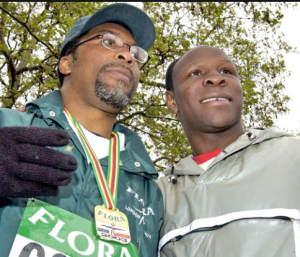
No one really expected Watson to live, much less talk or write. Yet, against all odds, he finished the London Marathon in 2003, capturing the hearts and minds of an entire nation. As people wept in joy and urged him on, Watson walked for six days. He reached his goal after 12 long years, way too many operations and hospitals, and far too many years in a wheelchair. But he trained for months and walked the entire 26 miles and 385 yards, finishing with Eubank and his neurosurgeon Peter Hamlyn at his side.
I was completely inspired. I felt tears falling from my eyes. It has lived with me forever. How do you expect that to make a man feel when you are called ‘The People’s Champion?’ That’s the one label they will never take away from me. — Watson
On 4 February 2004, Michael was awarded the MBE (Most Excellent Order of the British Empire) by H.M. Queen Elizabeth II.
Carl Thompson
Manchester-born Carl Thompson won the IBO cruiserweight title by beating Sebastian Rothmann in a closet classic and then turned right around and stopped contender and future champion David Haye in still another great fight in which Haye was winning but gassed out, allowing the cunning “Cat” to catch and claw him out. In 2001, The Cat lost his title to American Ezra Sellers in a fantastic slugfest in which both warriors were down multiple times. Thompson finished his career with six straight wins and will forever be adored by his fans as a humble but fierce warrior who participated in a number of true classics.
Reminiscent of the Norkus-Nardico classic, the Cat’s all-out Pier 6 with Sellers in 2001 produced six knockdowns (Thompson was knocked down four times, Sellers twice)! Sellers finally halted “The Cat” in the fourth round and ended a winning streak that had started after Thompson lost to Johnny Nelson in 1999. Thompson had been decked many times before, but he had always gotten up. Against Ezra, he was separated from his senses and sent to Feline Dreamland. This fight reliably demonstrated what can happen when two chill-or-be-chilled types face off.
It was truly a shame that Carl flew under the radar of American boxing writers and fans. In many ways, his exploits were just as noteworthy as those of Nigel Benn, Chris Eubank (whom he beat twice in 1998), or Michael Watson. Maybe it was because he fought as a cruiserweight (a lower profile weight division) but more likely it’s because he never fought outside of Europe.
Ted Sares can be reached at tedsares@roadrunner.com
Check out more boxing news on video at the Boxing Channel
To comment on this story in the Fight Forum CLICK HERE
-

 Featured Articles3 weeks ago
Featured Articles3 weeks agoAvila Perspective, Chap. 330: Matchroom in New York plus the Latest on Canelo-Crawford
-
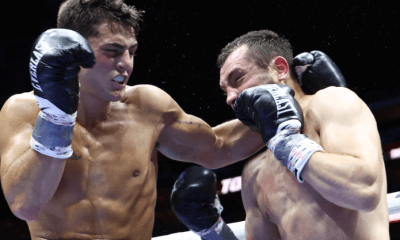
 Featured Articles2 weeks ago
Featured Articles2 weeks agoVito Mielnicki Jr Whitewashes Kamil Gardzielik Before the Home Folks in Newark
-
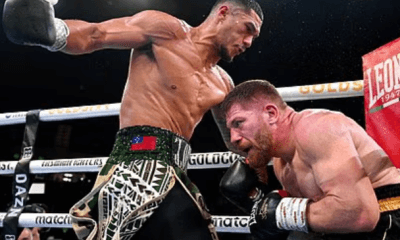
 Featured Articles4 weeks ago
Featured Articles4 weeks agoOpetaia and Nakatani Crush Overmatched Foes, Capping Off a Wild Boxing Weekend
-
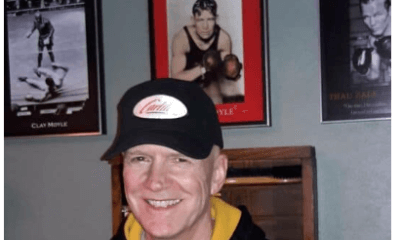
 Featured Articles3 weeks ago
Featured Articles3 weeks agoCatching Up with Clay Moyle Who Talks About His Massive Collection of Boxing Books
-

 Featured Articles4 weeks ago
Featured Articles4 weeks agoFabio Wardley Comes from Behind to KO Justis Huni
-
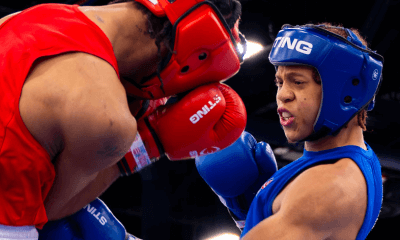
 Featured Articles2 weeks ago
Featured Articles2 weeks agoMore Medals for Hawaii’s Patricio Family at the USA Boxing Summer Festival
-
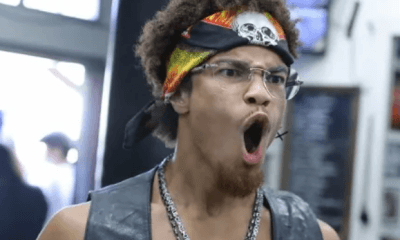
 Featured Articles3 weeks ago
Featured Articles3 weeks agoThe Shafting of Blair “The Flair” Cobbs, a Familiar Thread in the Cruelest Sport
-
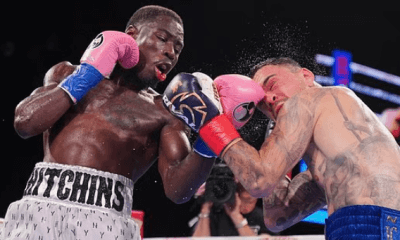
 Featured Articles3 weeks ago
Featured Articles3 weeks agoRichardson Hitchins Batters and Stops George Kambosos at Madison Square Garden

